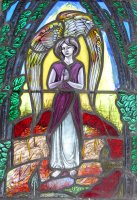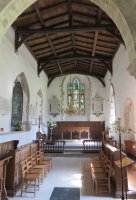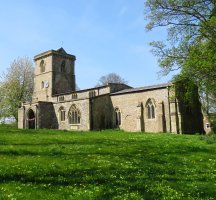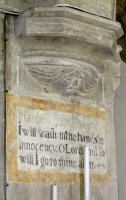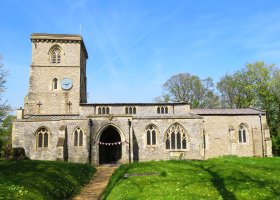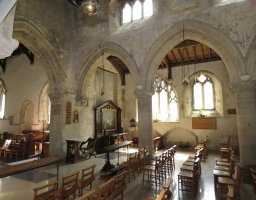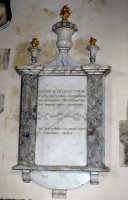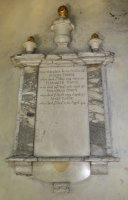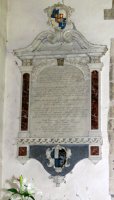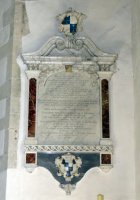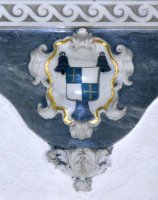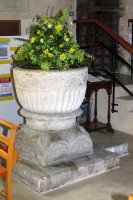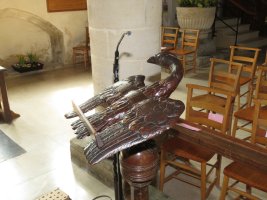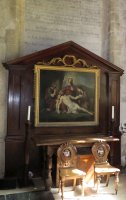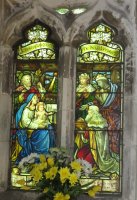Bledlow Church, Buckinghamshire - Monuments
Bledlow Church, Buckinghamshire, is a small, picturesque, low church of early medieval times, and notable for its ambient interior.
The exterior of Bledlow Church (Holy Trinity) is all flint and pale stone, mostly 13th Century, including the little tower, though the porch is somewhat later. The tower has neither spire nor battlements, and the roofs are rather flat and undecorated: a different look to how it used to be, for the Church once had a tall roof rising two thirds the height of the tower, as can be seen from the remaining weather course.
Bledlow Church, exterior and interior views.
The modestly scaled interior feels quite full, with low pillars, fragmentary carving and wall paintings and texts, niches and a large oil painting giving a medieval feel, added to by the wooden-beamed ceiling, though that dates from the 16th or 17th Century. I think it is this interior which is most interesting for the casual visitor, more so than the small number of monuments which are the interest of these pages. These few wall panels date from the 18th and 19th Centuries, with a few plain 20th Century pieces.
Monuments
John Towne, d.1725, and his wife Helen Towne, d.1739, with a Latin inscription. There are generous side-pieces to the inscribed panel, of striking white and black marble, acting as pilasters supporting entablature sehlf, on which rests a gadrooned [corrugated] pot with two flaming urns to the sides. At the base, a thinner shelf with two supports, and a blank central apron, with a smaller central support. Typical of a class of monochromatic panels of the time, using different black and white marbles for visual impact.
Monuments to John and Ralph Towne.
Ralph Towne, d.1755, Elizabeth Towne, d.1758, Susannah Towne, d.1759 and Mary Towne, d.1761. In the same style as the John Towne panel, with slight differences: less gadrooning on the upper pot, which along with the flaming urns to the side are a little more squat, slightly different proportions to the side pilasters, and the apron, and a different but no less arresting choice of monochromatic marbles.
Johnshall Crosse, d.1723, and Elizabeth [Blancks] Crosse, d.1720, who inherited the Manor of Bledlow Rectory etc, noting their descendants. One of a pair, along with the matching piece to Thomas Crosse, below, erected by Elizabeth [Crosse] Hayton, last survivor of eight grandchildren, presumably in 1748, when her mother died. A splendid panel of streaky white and coloured marbles. The inscription has above it relief carvings of crossed acanthus leaves, and to the sides, a dramatic red and white streaked marble inlay on flat pillars (pilasters), with stylised leaves above. Above that, shelf with mouldings and a swan-necked pediment, on which sits a painted cartouche of arms. At the base, another shelf, apron of grey marble cut in a curvy shape between two inlaid supports, and upon it, another cartouche of arms. A little terminus carved with leaves at the very bottom
Crosse monuments, and arms.
Lt. Thomas Crosse, d.1747, to the same design as the Johnshall Cross monument noted above, erected again by Elizabeth [Crosse] Hayton, 'the only Survivor and Sole Heiress of her once numerous Family'. Click on the pictures to enlarge and read the inscriptions.
The panels of later date are plain slabs:
Anne Blackden, d.1825, 'too delicately formed to bear the vicissitudes of rougher scenes', and her father Benjamin Blackden, d.1825. Panel with cut out corners and two small brackets.
Selina Hastings Robe Stephen, d.1841, white panel with inset arms on a black and white backing panel, signed I think by the stonemason Heaton.
Philip Gibbons, d.1842, his wife Mary Gibbons, d.1823, a granddaughter, Mary Gibbons, d.1834, and her mother, also Mary Gibbons, d.1854. Panel of streaky marble with cut out corners, and a small bracket.
Clement Oswald Skilbeck, d.1954, and his wife Elizabeth Bertha Skilbeck, d.1957. He is described as ‘painter and Church craftsman’, and the typically plain stone panel with a border, normal for post War monuments, is decorated by virtue of curls to the lettering, and two painted shields of arms.
And modern wooden panels, plain, to Edwin John Carton, d.1958 I think, Gordon James Struthdee, d.1975, and the Revd. T.H.D. Edwards, d.2002, Vicar and Rector from 1964-1989.
Also in the Church:
The font, a good one of the 12th Century, a great stone bowl with repeating decorations and fluting, resting on or within a short plinth on a raised base with pairs of Norman arches: this base makes it instantly recognisable as being one of the Aylesbury type of fonts scattered around the churches of the area.
We should remark on the heavy pillars which give so much to the atmosphere of the Church. They are from the 13th Century, and the capitals are decorated with foliage characteristic of the period.
A few pieces of carved masonry, including fragments of overlapping arches and other Norman repeating carving.
Two interesting low arched recesses within the south aisle wall, which would once have contained tombs, perhaps of a second founder or benefactor from the 13th Century enlargement of the Church - the local landowner Sir James Freysel and wife have been suggested. Above to one side is a piscina.
Wall paintings – they are too battered to be that satisfying except to the connoisseur, but help add to the ancient feel of the interior. The large one to the north side is apparently the remnants of a St Christopher.
A small brass to William Hern, d.1525, with standing figure in ecclesiastical garb facing forward, hands raised in prayer in the usual fashion.
A wooden eagle lectern, pre-Reformation apparently, though the column is modern, with a backward-turned head - an odd and unusual symbolism for a lectern. See picture below left.
The large painting, above an oak altar table, showing Christ descending from the Cross: it is by Samuel Wale, one of the founding members of the RA, more familiar for scenic and architectural engravings than full scale oil paintings. See picture below right (click to enlarge).
A squat chest, 18th Century.
A few pieces of good stained glass, mostly 19th Century, an ancient panel, and a modern angel.
Plain wooden panel to the fallen of Bledlow in WW1 and WW2.
Aylesbury-type font
Finally, to mention that while what remains is substantial, the Church had a 19th Century makeover, by George Gilbert Scott no less, believed to have been one of his more assertive restorations, thus potentially causing the loss of some other interior features.
The Church website is at http://www.bledlowparish.org.uk/Bledlow%20History.htm.
